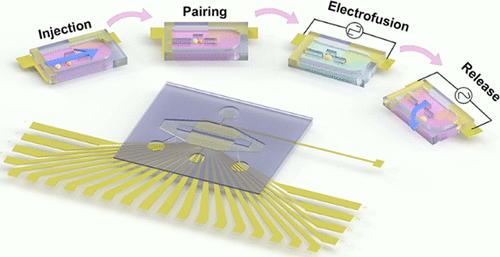当前位置:
X-MOL 学术
›
Anal. Chem.
›
论文详情
Our official English website, www.x-mol.net, welcomes your
feedback! (Note: you will need to create a separate account there.)
Microfluidic Chip for Cell Fusion and In Situ Separation of Fused Cells
Analytical Chemistry ( IF 6.7 ) Pub Date : 2024-11-19 , DOI: 10.1021/acs.analchem.4c04633 Yaqi Bai, Chen Yang, Xiaoling Zhang, Jie Wu, Jun Yang, Huangxian Ju, Ning Hu
Analytical Chemistry ( IF 6.7 ) Pub Date : 2024-11-19 , DOI: 10.1021/acs.analchem.4c04633 Yaqi Bai, Chen Yang, Xiaoling Zhang, Jie Wu, Jun Yang, Huangxian Ju, Ning Hu

|
Electrofusion is an effective method for fusing two cells into a hybrid cell, and this method is widely used in immunomedicine, gene recombination, and other related fields. Although cell pairing and electrofusion techniques have been accomplished with microfluidic devices, the purification and isolation of fused cells remains limited due to expensive instruments and complex operations. In this study, through the optimization of microstructures and electrodes combined with buffer substitution, the entire cell electrofusion process, including cell capture, pairing, electrofusion, and precise separation of the targeted fused cells, is achieved on a single chip. The proposed microfluidic cell electrofusion achieves an efficiency of 80.2 ± 7.5%, and targeted cell separation could be conveniently performed through the strategic activation of individual microelectrodes via negative dielectrophoresis, which ensures accurate release of the fused cells with an efficiency of up to 91.1 ± 5.1%. Furthermore, the survival rates of the cells after electrofusion and release are as high as 94.7 ± 0.6% and 91.7 ± 1.2%, respectively. These results demonstrate that the in situ cell electrofusion and separation process did not affect the cell activity. This chip offers integrated multifunctional manipulation of cells in situ, and can be applied to multiple fields in the future, thus laying the foundation for the field of precise single-cell analysis.
中文翻译:

用于融合细胞融合和原位分离的微流控芯片
电融合是将两个细胞融合成杂交细胞的有效方法,该方法广泛应用于免疫医学、基因重组等相关领域。尽管已经通过微流体设备完成了细胞配对和电融合技术,但由于昂贵的仪器和复杂的操作,融合细胞的纯化和分离仍然受到限制。在本研究中,通过微结构和电极的优化结合缓冲器替代,在单个芯片上实现了整个电池电融合过程,包括电池捕获、配对、电融合和目标融合电池的精确分离。所提出的微流控电池电熔效率为 80.2 ± 7.5%,并且可以通过负介电泳战略性地激活单个微电极来方便地进行靶向细胞分离,从而确保熔融电池的准确释放,效率高达 91.1 ± 5.1%。此外,电熔和释放后细胞的存活率分别高达 94.7 ± 0.6% 和 91.7 ± 1.2%。这些结果表明,原位电池电熔和分离过程不会影响电池活性。该芯片提供了对细胞原位的集成多功能操作,未来可应用于多个领域,从而为精确单细胞分析领域奠定基础。
更新日期:2024-11-19
中文翻译:

用于融合细胞融合和原位分离的微流控芯片
电融合是将两个细胞融合成杂交细胞的有效方法,该方法广泛应用于免疫医学、基因重组等相关领域。尽管已经通过微流体设备完成了细胞配对和电融合技术,但由于昂贵的仪器和复杂的操作,融合细胞的纯化和分离仍然受到限制。在本研究中,通过微结构和电极的优化结合缓冲器替代,在单个芯片上实现了整个电池电融合过程,包括电池捕获、配对、电融合和目标融合电池的精确分离。所提出的微流控电池电熔效率为 80.2 ± 7.5%,并且可以通过负介电泳战略性地激活单个微电极来方便地进行靶向细胞分离,从而确保熔融电池的准确释放,效率高达 91.1 ± 5.1%。此外,电熔和释放后细胞的存活率分别高达 94.7 ± 0.6% 和 91.7 ± 1.2%。这些结果表明,原位电池电熔和分离过程不会影响电池活性。该芯片提供了对细胞原位的集成多功能操作,未来可应用于多个领域,从而为精确单细胞分析领域奠定基础。

































 京公网安备 11010802027423号
京公网安备 11010802027423号